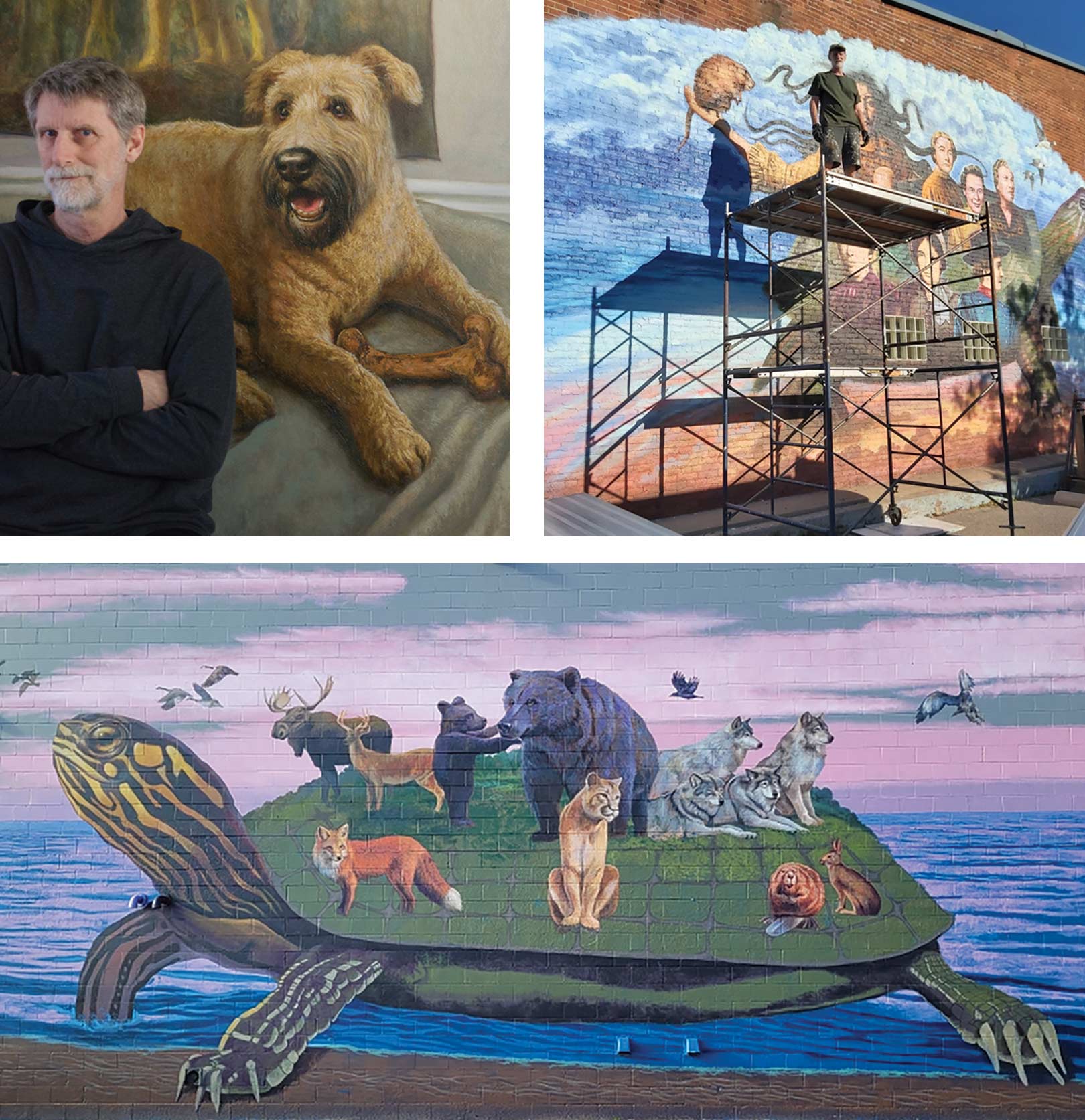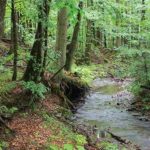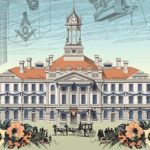

Allan Bender, a visual storyteller whose murals brighten cityscapes, landscapes – and even zooscapes – has spent a lifetime bringing brick and concrete walls to life with his art.
A self-proclaimed “bush kid” from Red Lake in Northern Ontario, Allan Bender had a tough time fitting into Grade 10 at Moira Secondary School when his family moved to Belleville in the 1970s. Inside the classroom, Allan was a handful. He felt more at home with the kids from Tyendinaga Mohawk Territory, when they were out hunting, fishing and exploring the woods.
His art teacher, perhaps desperate for a little peace and quiet in the classroom, gave Allan and another “troublemaker” kid an outlet for their pent-up energy: paint a mural above the lockers outside the art room. Both boys were history buffs, so they created a battle scene from the Peloponnesian War that was fought between Athens and Sparta from 431 to 404 BCE.
“It was the first time that I’d collaborated with somebody,” says Allan. “He had some really good ideas about the Greek wars and I had some really good ideas about how to put it on the wall.”
Allan credits his art teacher for seeing past his raucous exterior: “He was a very good teacher. He spotted the talent in me, encouraged me. And that’s probably what got it started.”
TAKING IT TO THE WALL
Fast forward to the present day: What was once a plain, grey-painted wall on a nondescript two-storey building in downtown Belleville is now bursting to life with a massive mural, Turtle Island, designed and created by Bender, who is the art director and owner of BlincStudios. You can see it from across the Moira River – a majestic turtle, carrying several woodland animals on her back, floats on water that reflects a dreamy cotton-candy-coloured sky. The detail is exquisite; the turtle’s eye is so lifelike she looks like she’s about to blink at any moment.
Allan admits mural painting can be as much a logistical challenge as an artistic one: is there parking in front of the wall? Is the wall deteriorating? Does it need repairing first?
Created in 2021, the mural was a sort of homecoming for Allan, who moved back to Belleville with his partner during the pandemic. While he and his crew of expert “paint-slingers” (and artists in their own right) have created hundreds of murals across North America – including over 300 for the Nashville-based O’Charley’s Restaurant chain alone – his very first mural was created here over fifty years ago on that wall above the high school lockers. While Allan had always been a “scribbler,” his first real foray into painting was at St. Lawrence College in Kingston after graduation, where he took traditional painting and drawing classes. He loved it. But to be a professional artist, he wanted marketable skills – and that meant learning photography as well as television and film production at York University in Toronto.
For about 25 years, Allan shuttled back and forth between work as a television and film producer and being a social services worker in the prison industry – a job that started as a means to put himself through school. “I made more money in television and film but had a much more satisfying time working in the prison industry,” he says.
THE BIG BREAK
Part of his role in television and film involved producing large events – and Allan was getting bored of it. In the late nineties, an artist friend he’d known for years came to him with a proposal: he’d been awarded a huge gig to paint murals for a restaurant chain in the US – three murals a month over 8 to 10 years – and he needed a business partner; someone to put together a production schedule, hire the artists, crunch the numbers and wield a paintbrush. Allan said yes.
His mural creations did so well in the US and Canada that in 2002 he bought the company. BlincStudios was born.
Aside from painting indoor and outdoor murals for restaurants, casinos, corporate headquarters and private commissions, Allan has been the lead artist for the Toronto Zoo for almost two decades, where he and his crew design and create exhibition murals. His landscapes create a backdrop for the animals: sweeping vistas with a photographic quality that transform concrete enclosures into wild spaces. His goal is to create an immersive experience for visitors, rather than a visual one.
“It’s not about walking into the exhibit and saying, ‘Oh, look – isn’t that a beautiful mural?’” says Allan. “The objective is to suspend disbelief, so that when you walk in there you think, ‘Oh, look – here we are in the savanna, and look at those giraffes over there!’”
Besides the exhibition murals at the Zoo, his crew also repairs and repaints the carousel and the animal images in the splash park. All this is in addition to his work restoring murals throughout Ontario: “I’m kind of a go-to guy when it comes to different types of artist materials, and how to restore and repair faded works or damaged walls,” he says.
Recently, Allan was commissioned to restore the Market Day mural in downtown Trenton. Created in 1995, it was showing signs of fading and damage. He sees restoration as a mental challenge as well as an artistic one, a sort of “channelling” of another artist, years or even decades after the mural was first painted: “I try to get a sense of where the artist was when he was mixing his colours, how he did the whole thing. It’s a kind of forensic approach to working with an artist who isn’t there.”
TELLING STORIES ON GREAT WALLS
Of all his many commissions and projects, Allan’s favourites are his outdoor narrative murals. Ten years ago, Toronto’s Chinatown Business Improvement Area commissioned BlincStudios to create a series of murals downtown. Allan and his crew, including artists John Nobrega and Stacey Kinder, transformed brick walls into exotic worlds featuring majestic Chinese dragons saturated with gorgeous bold colours and textures, historical figures and other mythical creatures, melding realism with delightful whimsy. They painted the Great Wall and The Forbidden City and captured traditional motifs and symbols of China with stunning attention to detail, using 17th- and 18th-century painting techniques traditionally done with a brush on canvas.
“We’re some of the last of the real painters,” says Allan. “We’re not abstract or graphic-y. It’s a painting technique that is very specific to me and BlincStudios.
“It’s not about walking into the exhibit and saying, ‘Oh, look – isn’t that a beautiful mural?’ The objective is to suspend disbelief, so that when you walk in there you think, ‘Oh, look – here we are in the savanna, and look at those giraffes over there!’” ALLAN BENDER
“We’ve got a way of covering up a great big wall so that when you walk up close, you can get a sense of these big fat brushstrokes. But if you stand back, it’s got lots of body, lots of depth, and people say, ‘Oh, yeah… that’s Bender and his crew.’” A mural is a product of its surroundings, and its execution is intimately linked to its location: the quality of light, the texture of the walls (brick or stucco, for example) and the elements that are already present, such as light fixtures or beams. Allan admits mural painting can be as much a logistical challenge as an artistic one: is there parking in front of the wall? Is the wall deteriorating? Does it need repairing first? And then there are the permissions, permits and licences not only to paint, but to erect the necessary scaffolding. “These are the kind of things that are part of the process before you even get to make your design and put it on the wall,” he says.
RETURNING TO HIS ROOTS
In 2020, BlincStudios was commissioned by the Iron Workers Local 721 in Toronto to create a large multi-storey mural across from the union building. The concept and design stage took approximately three weeks, and the installation took another six to eight weeks. In the mural, Allan captured images of old friends from Tyendinaga, many of whom became ironworkers.
That same year, the municipality of Clarington commissioned BlincStudios to create a mural as part of a public art project funded by a large community improvement grant. The mural, called The Sky Woman and Turtle Island, features women who have been influential throughout Bowmanville’s history, depicted on the back of another majestic turtle. It was the first time Allan used the First Nations creation story as a means to tell a story.
He’s quick to dismiss any whispers of cultural appropriation. He still rides motorcycles with his Mohawk friends, who “don’t have a problem” with his work. The origins of his storytelling go back to his formative teenage years: “My friends from Tyendinaga sat behind me in history class, and they gave me their history lessons … and it made sense to me,” he says. His move back to Belleville felt like a “full-circle thing happening.”
Allan affirms he’s a visual storyteller, and he doesn’t have an agenda with his murals. He’s not trying to convey some sort of particular message. “I think I can be very observant. I see stuff. And I now have the tools and ability to express what I see in visual ways,” he says.
What does he want viewers to experience when they look at his murals?
“I’m hoping that anybody who sees my work has their own experience,” says Allan. “Just the fact that somebody is willing to stop, look and interact is the first success. The continuous success depends on where they go next … whatever gets them to reflect on something, or have a second, third or fourth look, or discuss what I’ve just painted – that’s what I go for.”
blincstudios.com
Story by:
Fiona Campbell



